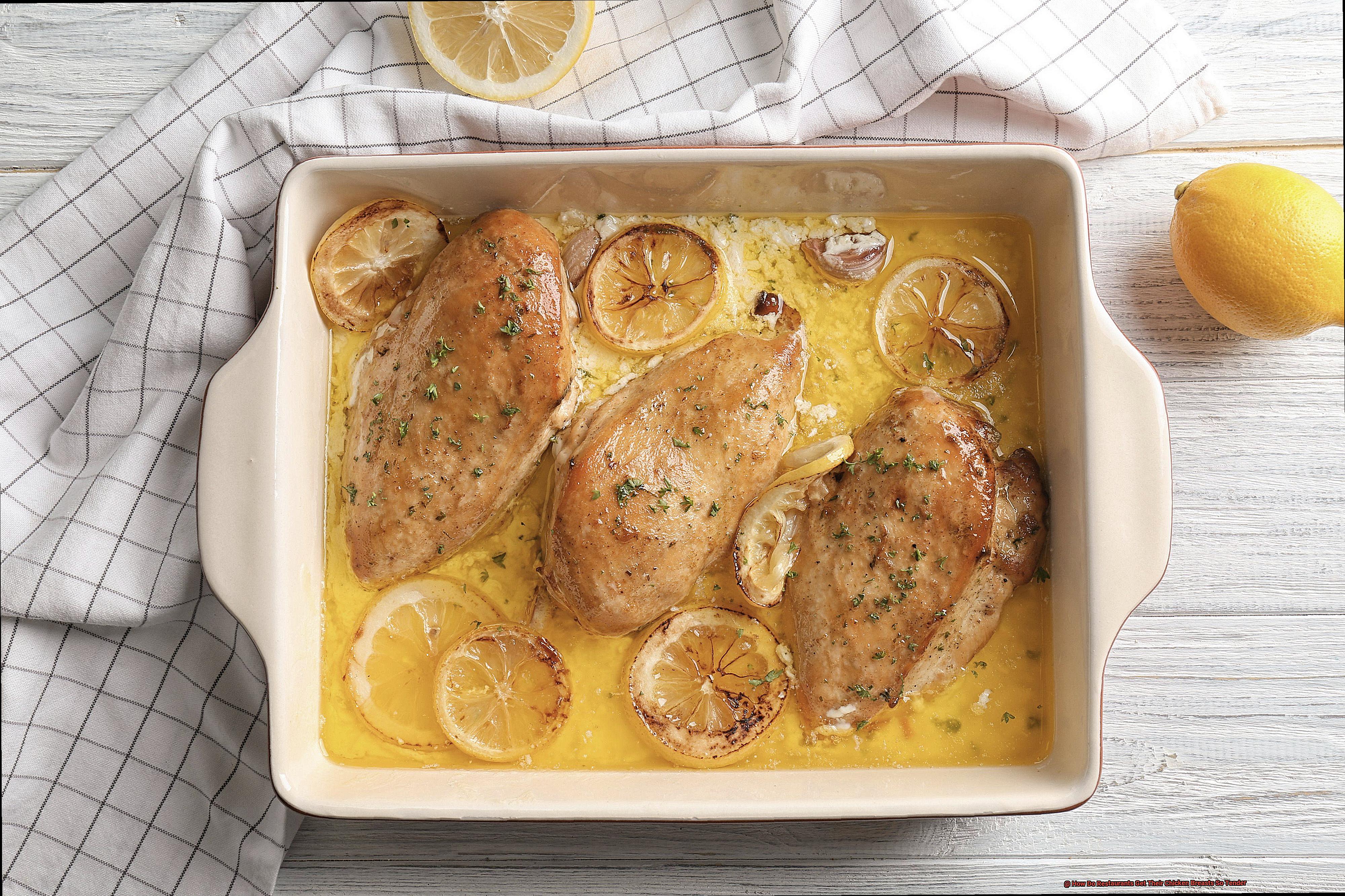Do you ever find yourself at a restaurant, marveling at how tender and juicy their chicken dishes are? Meanwhile, your own home-cooked chicken always seems to come out dry and tough. It’s a common struggle for many home cooks, but fear not. Achieving that perfect succulence is easier than you might think.
To start, it’s important to understand that restaurants have access to more resources and time when preparing their chicken. They often use high-quality, hormone-free chickens that are air-chilled instead of water-chilled. This cooling method helps the meat retain moisture and flavor.
Marinating is another technique that restaurants use to create tender chicken. Not only does it add delicious flavor, but it also helps break down the connective tissue in the meat. Some establishments even brine their chicken by soaking it in a saltwater solution before cooking.
Finally, restaurants often employ specialized equipment like sous vide or low-heat slow cooking methods to cook their chicken evenly and retain moisture. The result? A juicy, tender final product.
But don’t worry – you don’t need fancy equipment or extensive training to achieve similar results at home. Incorporating some of these techniques into your own cooking routine can make all the difference. Stay tuned for our comprehensive guide on how to make restaurant-quality tender chicken in your own kitchen.
Contents
Marination: The Benefits and Techniques of Marinating Chicken
This technique involves soaking chicken in a mixture of acid, oil, and spices, resulting in tender, flavorful meat. Let’s dive into the benefits and techniques of marinating chicken.
Benefits of Marination
Marination offers a multitude of benefits, including:
Marination Techniques
There are several techniques for marinating chicken, including:
- Plastic Bag Method: Place the chicken and marinade in a plastic bag, seal it, and refrigerate for several hours or overnight. This method ensures even coating of the marinade.
- Container Method: Place the chicken and marinade in a container with a lid, ensuring that the chicken is fully submerged. Refrigerate for several hours or overnight.
- Injection Method: Using a marinade injector, inject the marinade directly into the chicken meat for maximum absorption.
Different Types of Marinades
Restaurants experiment with different combinations of spices and liquids to create unique and delicious marinades. Here are some popular marinades to try at home:
- Lemon Herb: A mixture of lemon juice, olive oil, garlic, and herbs such as thyme and rosemary.
- Garlic and Ginger: A mixture of soy sauce, garlic, ginger, honey, and sesame oil.
- Teriyaki: A mixture of soy sauce, brown sugar, ginger, garlic, and rice vinegar.
Brining: How to Achieve Perfectly Moist and Juicy Chicken
It’s time to discover the magic of brining. As an expert in the art of achieving perfectly moist and juicy chicken, I am excited to share with you my top tips for using the brining technique to elevate your cooking game.
Brining is a simple yet effective process that involves soaking chicken in a solution of salt and water. By doing so, the proteins in the chicken break down, allowing it to absorb more moisture during cooking. But that’s not all – adding other seasonings like herbs, spices, or sugar to the brine can also infuse your chicken with extra flavor.
To get started with brining, you’ll need to mix up a solution of salt and water. A good rule of thumb is to use 1 tablespoon of salt for every cup of water. Don’t be afraid to get creative with your seasonings – try adding garlic, bay leaves, or even citrus zest for an extra burst of flavor.
Once you have your solution ready, fully submerge your chicken breasts in the brine and let them soak for at least 30 minutes (but no longer than 24 hours). When you’re ready to cook, be sure to pat your chicken breasts dry with paper towels before seasoning and cooking. This will help ensure that they brown properly and don’t become too soggy.
Now, let’s talk about cooking methods. Brined chicken can be cooked using a variety of methods including grilling, baking, or frying. The key is to make sure you don’t overcook the chicken as it will already be more tender and juicy from the brine. Whether you’re grilling up some kebabs or baking a whole bird, brining can take your chicken dishes from mediocre to mouth-watering.
Slow-Cooking Method: The Benefits of Low Temperature Cooking
The slow-cooking method may be the solution you’ve been searching for. As an expert on this topic, I can confidently say that the benefits of low-temperature cooking are numerous.
One of the most significant advantages of slow-cooking is achieving tender and juicy chicken. By cooking the meat at a low temperature for an extended period, it cooks evenly without losing moisture. This guarantees that your chicken will never be dry and tasteless again.
Furthermore, slow-cooking preserves the natural flavors of the chicken. Unlike boiling or frying, which can strip away some of the flavors, low-temperature cooking allows you to experience the complete flavor profile of the meat. This means that you can finally savor all the delicious flavors that your chicken has to offer.
To achieve perfectly cooked chicken breasts, it’s crucial to maintain a consistent low temperature. Aim for around 160-170°F for 2-3 hours, depending on the thickness of your breasts. Additionally, slow-cooking provides ample time to season and flavor your chicken according to your preferences. So feel free to experiment with different marinades and seasonings to find what works best for you.
Specialized Equipment: Using Sous Vide Machines and Pressure Cookers for Perfectly Cooked Chicken
Look no further than specialized equipment such as sous vide machines and pressure cookers. These tools have become increasingly popular in restaurants because of their ability to cook food evenly and consistently.
Sous vide machines work by sealing chicken breasts in a vacuum-sealed bag and immersing them in a water bath at a precise temperature for an extended period. This cooking method ensures that the poultry is cooked evenly without overcooking or drying out. The result is a tender and juicy chicken breast that is bursting with flavor. Plus, the ability to experiment with different marinades and spices means you can customize your dish to your liking.
If you need to serve large quantities of chicken quickly, then a pressure cooker is your best bet. The high-pressure steam forces moisture into the chicken, resulting in a juicy texture that will leave your guests wanting more. However, it’s essential to monitor the cooking time carefully to avoid overcooking.
To achieve perfectly cooked chicken, it’s crucial to use high-quality ingredients. Fresh herbs, spices, and marinades can make all the difference when it comes to flavor. You can also add aromatics such as garlic or lemon to infuse extra flavor into your dish.
Combining Techniques for Maximum Flavor and Tenderness
The key to achieving maximum flavor and tenderness in chicken breasts is by combining different techniques. Here are some methods that restaurants use to achieve this:
Firstly, marinating your chicken breasts is a classic technique that involves soaking them in a mixture of acids, oils, and spices. The acids break down the proteins in the meat, tenderizing it and infusing it with delicious flavors. You can experiment with different marinades depending on your taste preference, from classic lemon-herb to spicy chipotle.
Secondly, brining is another technique that can help your chicken retain moisture during cooking. It involves soaking the chicken in a saltwater solution, which breaks down the proteins and helps the meat stay juicy. You can also add aromatics like garlic or bay leaves to give your chicken even more flavor.
Thirdly, sous vide cooking is a popular method used by restaurant chefs to achieve perfectly cooked and tender chicken breasts. With this technique, the chicken is vacuum-sealed in a plastic bag and cooked in a water bath at a precise temperature. This ensures that the meat is cooked evenly and retains its moisture, resulting in incredibly tender meat.
Lastly, using a meat mallet can help tenderize tough cuts of meat like chicken breasts. By pounding the meat with a mallet, you can break down its fibers and make it more tender. This technique is often used in combination with other methods like marinating or brining.
Different Types of Marinades and Brines to Try Out
If you’ve ever tried to cook chicken breasts, you know how difficult it can be to achieve a juicy and tender result. Fortunately, the use of marinades and brines can make all the difference in the world. These techniques are used by restaurant chefs to ensure that their chicken is as tender and flavorful as possible. Let’s dive into the different types of marinades and brines that can help you achieve the same results at home.
Acidic Marinades
The most common type of marinade is one that uses acidic ingredients like vinegar, lemon juice, or wine. These ingredients help to break down the proteins in the chicken, resulting in a more tender and flavorful end product. A simple marinade can be made with lemon juice, olive oil, garlic, and herbs like rosemary or thyme.

Soy-based Marinades
Another popular type of marinade is one that is inspired by Asian cuisine. Soy sauce, ginger, and sesame oil are commonly used in these marinades to add a savory flavor to the chicken. They work well with stir-fries or grilled dishes.
Yogurt-based Marinades
Mediterranean-inspired marinades use yogurt, lemon juice, and spices like cumin or coriander. These ingredients add a creamy and tangy flavor to the chicken and pairs well with rice pilaf or roasted vegetables.
Saltwater Brine
Brines are a solution of salt, water, and sugar that are used to soak meat for several hours before cooking. A basic brine can be made with water, salt, brown sugar, and spices like bay leaves or peppercorns. The salt in the brine helps to break down muscle fibers, making it more tender while keeping the chicken moist during cooking.
Beer Brine
For a unique twist on traditional brines, try using beer instead of water for a unique flavor. Add honey for extra sweetness and spices like mustard seeds or bay leaves for depth of flavor.
When using marinades or brines, it’s important to follow proper food safety guidelines. Always marinate or brine chicken in the refrigerator and discard any leftover marinade or brine after use. Also, be sure to rinse off any excess marinade or brine before cooking to prevent burning or uneven cooking.
Different Types of Herbs, Spices, and Oils to Enhance Your Chicken’s Flavor
No need to worry, as there are several ways to enhance the flavor and tenderness of your chicken. Here are five sub-sections that will guide you through different types of herbs, spices, and oils to make your chicken more flavorful and juicy.
Herbs
Herbs are an excellent way to add flavor and tenderness to chicken. Rosemary, thyme, and oregano are commonly used herbs in chicken dishes. Rosemary has a strong and earthy flavor that pairs well with chicken, while thyme has a slightly sweet taste. Oregano has a peppery and slightly bitter taste that adds depth to the dish. These herbs have natural tenderizing properties that break down proteins in the meat, making it more tender.
Spices
Spices can add a burst of flavor and complexity to your chicken dishes. Paprika, cumin, and garlic powder are popular choices for enhancing the flavor of chicken. Paprika adds a smoky sweetness, cumin has a warm and nutty taste, while garlic powder provides a savory and pungent flavor. These spices can help mask any undesirable flavors in the meat while adding depth and complexity to the dish.
Oils
Oils are another key ingredient that can tenderize chicken while adding richness and depth of flavor to the dish. Olive oil is a popular choice as it contains monounsaturated fats that help break down proteins in the meat, making it more tender. It also adds a subtle fruity flavor to the meat. Avocado oil is another option that can be used for its high smoke point and mild taste that won’t overpower the other flavors in the dish.
Marination
Marinating chicken in a flavorful liquid for several hours infuses it with flavor and moisture while breaking down proteins in the meat, making it more tender. Try marinating with lemon juice, soy sauce, or yogurt for added tenderness and flavor. You can also add herbs and spices to the marinade for even more flavor.
Brining
Brining is a technique that involves soaking chicken in a saltwater solution overnight, which helps to break down muscle fibers and create a juicy and tender texture. Be sure to rinse the chicken thoroughly after brining to remove excess salt. You can also add herbs and spices to the brine for added flavor.
Tips on How to Ensure Perfectly Cooked Chicken Every Time
With a few tips and tricks, you can achieve perfectly cooked chicken every time. Here are five sub-sections to help you improve your chicken cooking game.
Proper Preparation:
Before cooking your chicken, it’s important to properly prepare it. Cleaning the chicken thoroughly and removing excess fat or skin helps the seasoning and marinade penetrate the meat, creating a more flavorful and tender chicken breast. If you’re using bone-in chicken, make sure to remove the bone cartilage as well.
Seasoning and Marinating:
Seasoning and marinating are crucial steps in achieving tender and juicy chicken breasts. A simple marinade of olive oil, lemon juice, garlic, and herbs can do wonders for chicken breasts. You can also season your chicken with simple ingredients like salt, pepper, garlic powder, and onion powder. The key is to let the seasoning and marinade sit for at least an hour before cooking to allow the flavors to seep into the meat.
Grilling:
Grilling is a popular choice for many because it imparts a smoky flavor and creates those beautiful grill marks on the chicken. To ensure even cooking, make sure to preheat the grill before placing the chicken breasts on it. Be careful not to overcook the chicken on the grill as it can dry out quickly. Try using indirect heat or a lower temperature setting on your grill to keep the chicken moist.
Baking:
Baking is another great option for cooking chicken at home. To ensure your chicken stays tender and juicy when baking, cover it with foil for the first half of the cooking time and then remove it for the second half to allow for browning. This helps trap in moisture and creates a more evenly cooked chicken breast.
Temperature:
Using a meat thermometer is key to ensuring your chicken is cooked through without overcooking it. The internal temperature of cooked chicken should reach 165°F (74°C) for safe consumption. Be sure to check the temperature in the thickest part of the chicken breast to ensure it’s fully cooked.
Conclusion
In conclusion, creating succulent and juicy chicken at home is not rocket science. While restaurants have more resources and time to devote to preparing their chicken, home cooks can still achieve similar results by incorporating some of their techniques into their cooking routine. Techniques such as marinating, brining, slow-cooking, using specialized equipment like sous vide machines or pressure cookers, and combining different methods can all contribute to maximum flavor and tenderness in chicken.
To add a burst of flavor to your chicken dishes, herbs like rosemary and thyme, spices such as paprika and garlic powder, oils like olive oil and avocado oil are all great options. Marination with flavorful liquids or brining in a saltwater solution can also make a significant difference. Proper preparation, seasoning, and marinating the chicken before grilling or baking it in the oven are crucial steps to ensure that the meat stays moist and tender.
By following these tips and tricks for achieving perfectly cooked chicken every time, home cooks can impress their guests with mouth-watering dishes that rival those served in restaurants.






